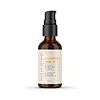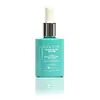What's inside
What's inside
 Key Ingredients
Key Ingredients

 Benefits
Benefits

 Concerns
Concerns

 Ingredients Side-by-side
Ingredients Side-by-side

Water
Skin ConditioningGlycerin
HumectantSodium Ascorbyl Phosphate
AntioxidantCitrus Paradisi Peel Oil
MaskingHamamelis Virginiana Extract
AntiseborrhoeicCassia Angustifolia Seed Polysaccharide
Skin ConditioningSodium Hyaluronate
HumectantGlobularia Cordifolia Callus Culture Extract
Skin ConditioningGlycyrrhiza Glabra Root Extract
BleachingCamellia Sinensis Leaf Extract
AntimicrobialGinkgo Biloba Leaf Extract
Skin ConditioningFucus Vesiculosus Extract
EmollientPunica Granatum Extract
AstringentArgania Spinosa Kernel Oil
EmollientLaminaria Saccharina Extract
Skin ProtectingCamellia Oleifera Leaf Extract
AstringentRosa Canina Fruit Oil
EmollientHippophae Rhamnoides Fruit Oil
Skin ProtectingFerulic Acid
AntimicrobialLimnanthes Alba Seed Oil
Skin ConditioningGlucosyl Hesperidin
HumectantRosmarinus Officinalis Leaf Extract
AntimicrobialCentella Asiatica Extract
CleansingHibiscus Rosa-Sinensis Flower Extract
HumectantCarbomer
Emulsion StabilisingTocopherol
AntioxidantDaucus Carota Sativa Seed Oil
EmollientPrunus Armeniaca Kernel Oil
MaskingEquisetum Arvense Extract
AstringentTaraxacum Officinale Leaf Extract
Skin ConditioningGeranium Maculatum Extract
TonicHelianthus Annuus Seed Oil
EmollientXanthan Gum
EmulsifyingSodium Hydroxide
BufferingPropanediol
SolventPhenethyl Alcohol
MaskingPentylene Glycol
Skin ConditioningWater, Glycerin, Sodium Ascorbyl Phosphate, Citrus Paradisi Peel Oil, Hamamelis Virginiana Extract, Cassia Angustifolia Seed Polysaccharide, Sodium Hyaluronate, Globularia Cordifolia Callus Culture Extract, Glycyrrhiza Glabra Root Extract, Camellia Sinensis Leaf Extract, Ginkgo Biloba Leaf Extract, Fucus Vesiculosus Extract, Punica Granatum Extract, Argania Spinosa Kernel Oil, Laminaria Saccharina Extract, Camellia Oleifera Leaf Extract, Rosa Canina Fruit Oil, Hippophae Rhamnoides Fruit Oil, Ferulic Acid, Limnanthes Alba Seed Oil, Glucosyl Hesperidin, Rosmarinus Officinalis Leaf Extract, Centella Asiatica Extract, Hibiscus Rosa-Sinensis Flower Extract, Carbomer, Tocopherol, Daucus Carota Sativa Seed Oil, Prunus Armeniaca Kernel Oil, Equisetum Arvense Extract, Taraxacum Officinale Leaf Extract, Geranium Maculatum Extract, Helianthus Annuus Seed Oil, Xanthan Gum, Sodium Hydroxide, Propanediol, Phenethyl Alcohol, Pentylene Glycol
Water
Skin ConditioningMethylpropanediol
SolventAscorbic Acid
AntioxidantPropylene Glycol
HumectantPolysorbate 20
EmulsifyingGlycerin
HumectantLaureth-23
CleansingKojic Acid
AntioxidantAlpha-Arbutin
AntioxidantAzelaic Acid
BufferingButylene Glycol
HumectantCamellia Sinensis Leaf Extract
AntimicrobialCitrus Aurantium Dulcis Peel Oil
MaskingDiethanolamine
BufferingEthoxydiglycol
HumectantEuterpe Oleracea Fruit Extract
Ferulic Acid
AntimicrobialGlutathione
Niacinamide
SmoothingPanthenol
Skin ConditioningPhenoxyethanol
PreservativeRetinyl Palmitate
Skin ConditioningSodium Hyaluronate
HumectantTocopherol
AntioxidantTriethanolamine
BufferingWater, Methylpropanediol, Ascorbic Acid, Propylene Glycol, Polysorbate 20, Glycerin, Laureth-23, Kojic Acid, Alpha-Arbutin, Azelaic Acid, Butylene Glycol, Camellia Sinensis Leaf Extract, Citrus Aurantium Dulcis Peel Oil, Diethanolamine, Ethoxydiglycol, Euterpe Oleracea Fruit Extract, Ferulic Acid, Glutathione, Niacinamide, Panthenol, Phenoxyethanol, Retinyl Palmitate, Sodium Hyaluronate, Tocopherol, Triethanolamine
 Reviews
Reviews

Ingredients Explained
These ingredients are found in both products.
Ingredients higher up in an ingredient list are typically present in a larger amount.
Camellia Sinensis Leaf Extract is derived from the leaves of the tea plant. Black tea, green tea, and oolong tea are all harvested from this plant.
This ingredient has many skin benefits:
This ingredient contains polyphenols, a strong antioxidant. Antioxidants help fight off molecules that damage skin cells.
On top of that, the antioxidants in green tea neutralize free-radicals from the sun. This gives the skin some extra UV protection, but should not replace sunscreen.
Many components of tea have anti-inflammatory properties.
Polyphenols and L-theanine help soothe the skin and reduce irritation. The caffeine in Camellia Sinensis Leaf Extract helps calm inflamed blood vessels.
Other compounds found in tea include: Vitamin Bs, linoleic acid, magnesium, calcium, iron, and zinc.
Research has shown both drinking Camellia Sinensis Leaf Tea and applying it to the skin can help boost skin elasticity and hydration. Studies also show using tea extract may reduce sebum, or oil, production.
Learn more about Camellia Sinensis Leaf ExtractFerulic Acid is a plant based antioxidant. By fighting free-radicals, ferulic acid can help reduce the formation of fine lines and hyperpigmentation.
When used with Vitamin C, Ferulic Acid has shown to prevent Vitamin C from breaking down. In other words, it acts as a stabilizer.
Ferulic Acid is sometimes used to preserve food. Foods containing Ferulic Acid include: oats, rice, eggplant, citrus.
In medicine, Ferulic Acid is being studied for helping with diabetes, Alzheimer's, and cardiovascular diseases.
Learn more about Ferulic AcidGlycerin is already naturally found in your skin. It helps moisturize and protect your skin.
A study from 2016 found glycerin to be more effective as a humectant than AHAs and hyaluronic acid.
As a humectant, it helps the skin stay hydrated by pulling moisture to your skin. The low molecular weight of glycerin allows it to pull moisture into the deeper layers of your skin.
Hydrated skin improves your skin barrier; Your skin barrier helps protect against irritants and bacteria.
Glycerin has also been found to have antimicrobial and antiviral properties. Due to these properties, glycerin is often used in wound and burn treatments.
In cosmetics, glycerin is usually derived from plants such as soybean or palm. However, it can also be sourced from animals, such as tallow or animal fat.
This ingredient is organic, colorless, odorless, and non-toxic.
Glycerin is the name for this ingredient in American English. British English uses Glycerol/Glycerine.
Learn more about GlycerinSodium Hyaluronate is hyaluronic acid's salt form. It is commonly derived from the sodium salt of hyaluronic acid.
Like hyaluronic acid, it is great at holding water and acts as a humectant. This makes it a great skin hydrating ingredient.
Sodium Hyaluronate is naturally occurring in our bodies and is mostly found in eye fluid and joints.
These are some other common types of Hyaluronic Acid:
Learn more about Sodium HyaluronateTocopherol (also known as Vitamin E) is a common antioxidant used to help protect the skin from free-radicals and strengthen the skin barrier. It's also fat soluble - this means our skin is great at absorbing it.
Vitamin E also helps keep your natural skin lipids healthy. Your lipid skin barrier naturally consists of lipids, ceramides, and fatty acids. Vitamin E offers extra protection for your skin’s lipid barrier, keeping your skin healthy and nourished.
Another benefit is a bit of UV protection. Vitamin E helps reduce the damage caused by UVB rays. (It should not replace your sunscreen). Combining it with Vitamin C can decrease sunburned cells and hyperpigmentation after UV exposure.
You might have noticed Vitamin E + C often paired together. This is because it is great at stabilizing Vitamin C. Using the two together helps increase the effectiveness of both ingredients.
There are often claims that Vitamin E can reduce/prevent scarring, but these claims haven't been confirmed by scientific research.
Learn more about TocopherolWater. It's the most common cosmetic ingredient of all. You'll usually see it at the top of ingredient lists, meaning that it makes up the largest part of the product.
So why is it so popular? Water most often acts as a solvent - this means that it helps dissolve other ingredients into the formulation.
You'll also recognize water as that liquid we all need to stay alive. If you see this, drink a glass of water. Stay hydrated!
Learn more about Water